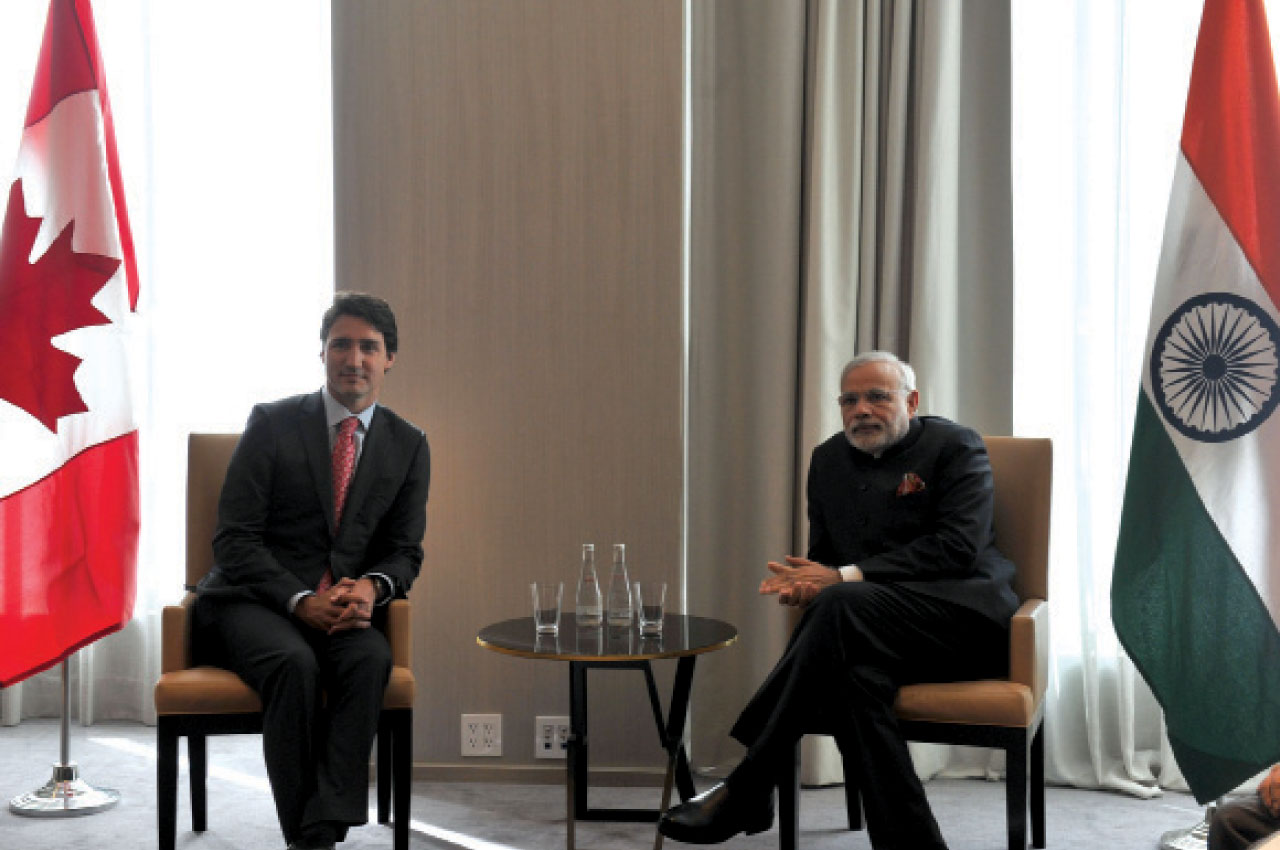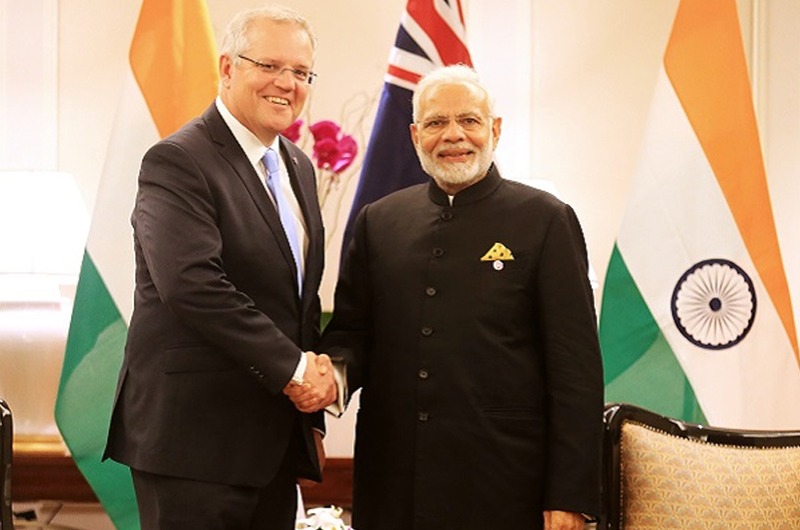 India and Canada have a long history of friendly relations by virtue of the commonalities of the two countries such as colonial legacy, democratic polity, rich cultural diversity, parliamentary institutions and commitment to international peace and security. Over the years, such relations have been further augmented through their constructive role as members of multilateral forums such as the United Nations (UN), World Trade Organization (WTO), the G7, G8, G-20, ASEAN Regional Forum (ARF) and Organization of Economic Co-operation & Development (OECD) working in the areas of peace, sustainable development, trade and commerce. The visit of Prime Minster of India to Canada in April 2015 – the first bilateral visit to this country by an Indian Prime Minister since 1973 – has added a new chapter in the history of India-Canada relations.
India and Canada have a long history of friendly relations by virtue of the commonalities of the two countries such as colonial legacy, democratic polity, rich cultural diversity, parliamentary institutions and commitment to international peace and security. Over the years, such relations have been further augmented through their constructive role as members of multilateral forums such as the United Nations (UN), World Trade Organization (WTO), the G7, G8, G-20, ASEAN Regional Forum (ARF) and Organization of Economic Co-operation & Development (OECD) working in the areas of peace, sustainable development, trade and commerce. The visit of Prime Minster of India to Canada in April 2015 – the first bilateral visit to this country by an Indian Prime Minister since 1973 – has added a new chapter in the history of India-Canada relations.
The Prime Minister’s visit was epoch-making in many respects. The visit paved the way for elevating the bilateral relations into a strategic partnership between India and Canada in many key sectors. The joint statement issued during the visit by the heads of two nations underlined that concrete steps would be taken to expand bilateral cooperation in key areas such as the economy & trade, investment, energy or civil nuclear cooperation, science & technology, agriculture, defence and security, innovation and space and others. for which a number of Memorandum of Understanding (MoU) or agreements have been signed. More significantly, the Prime Minister’s visit helped to explore Canada’s capability and expertise to prop-up Modi-government’s highly visionary initiatives such as Clean India, Digital India and Make in India, besides other innovative schemes such as Smart Cities, Skills-development and others.
The Economic progress and health of any country is closely co-related to the quantum of investment- the domestic as well as the Foreign. The more the inflow of foreign capital to domestic economy, the greater be its strength. Many Canadian companies such as SNC Lavalin, Bombardier, RIM, CAE Electronics, Sun Life, MDS Nordion, BCE, and others have started their ventures in India. In 2014, the cumulative Canadian Foreign Direct Investment (FDI) in India was C$1128 million. On the other hand, over the last few years, Indian investment in Canada has substantially increased especially in certain sectors like Information Technology (IT), software and natural resources. The leading Indian corporate giants such as TATA, Aditya Birla, Essar, Mahindra, Infosys, and WIPRO etc have their major operations in Canada. Naturally, the cumulative Indian investment in Canada has increased to C$3973 million in 2014.
Just as in the case of investment, there is much scope to improve the bilateral merchandise trade between Canada and India. Though India is Canada’s largest trading partner in South Asia and is identified as a priority market under Canada’s Global Markets Action Plan, the two-way trade in 2014 stood at C$6.4 billion, which was less than one percent of Canada’s global trade. While the Canadian exports to India during 2014 were to the tune of $3.1 billion, the exports from India to Canada totalled over $3.0 billion. Canada’s major items of export to India include: pulses, newsprint, wood-pulp, asbestos, Potash, iron-scrap, copper, mineral and industrial products. The major items of Indian exports are medicines, garments, diamonds, chemicals, gems and jewellery, petroleum oils, made-up, sea food, engineering goods, marble and granite, knitted garments, rice, electric equipment, plastic products, .
What could be done to boost the investment and trade? First and foremost is the creation of right investment climate through sound policies and strategies. The Modi-government’s economic growth agenda of show-casing India to the world and making the country friendlier to global economy and commerce would attract more and more foreign investors to India. According to the OECD, within the next fifteen years, the Indian Economy will grow to represent around one-tenth of the entire global economy. Canada which is in the path of free trade and investment with countries like India can definitely make use of such opportunities. They have already identified certain sectors like Infrastructure, Autos, Services (telecommunication &Banking) and Energy security as ‘sweet-spot’ for investment.
Secondly, successful implementation of institutional mechanisms or arrangements by India and Canada will give a fillip to economy and trade. Already a number of such initiatives have been worked out. They include Trade Policy Consultations (holding annual trade policy consultations in India and Canada on rotation basis for expanding bilateral trade and investment); Annual Trade Ministerial Dialogue; setting up of the India-Canada Forum for Environmental Cooperation (to discuss and formulate policy guidelines on environmental issues)and the Canada-India Energy Forum ( for better co-operation in Energy sector); the India-Canada Chief Executive Officers’ Forum( to improve trade and investment flows between Canada and India through exchange of ideas etc)and the launching of Canada-India Centre for Excellence in Science, Technology, Trade and Policy. Besides, sector-wise agreements between the two countries on trade practices and investment guidelines have helped to clear many grey areas in those sectors.
Some recent efforts in the above direction are quite significant. One such mechanism is Strategic Dialogue which is intended to provide a long-term strategic direction to the bilateral relations by focusing on the priority areas like investment and trade. In the 2nd Round of Dialogue held in New Delhi during October 2014, important bilateral issues such as defence, energy, nuclear cooperation, counter-terrorism, global and regional security were discussed. In fact, such endeavours have gained more momentum during the visit of Prime Minister Modi to Canada, when the Prime Ministers of both the countries reiterated their commitment to pursue specific measures such as the Bilateral Foreign Investment Promotion and Protection Agreement (BIPPA) in order to elevate two-way trade and investment linkages to full potential. Once the Agreement is finalized, it will give further boost to two-way investment especially the Canadian investment into India’s priority areas like infrastructure, manufacturing, and Smart Cities under the Make in India campaign.
A similar mechanism of greater importance is the Comprehensive Economic Partnership Agreement (CEPA) which can increase bilateral trade by 50 percent, and boost the Gross Domestic Product (GDP) of each country by $6 billion. It may also provide great opportunity for Canada-India commercial collaboration in areas of strategic importance to India, while creating jobs and economic growth for both countries.
Above all the Indian Diaspora in Canada with their strong ancestral and cultural bonds in India and wide-ranging activities in the socio-economic, cultural and political spheres of Canada play a vital role in strengthening the bilateral relations between the two countries. Over 1.2 million Persons of Indian Origin (PIO) who constitute more than 3 percent of the country’s population are well assimilated with the mainstream and serve as a strong bridge between the two nations. They really form a microcosm of Canada and make significant contributions in the onward march of the country as a major economic power.
The words of Attorney David Cohen reflect this truth: “Canada’s success and growth as a country is intimately tied to the growth of its immigrant communities. It has been my great pleasure to help many Indian citizens come to Canada to live and work. I know that with every new arrival, our country is becoming richer both economically and culturally”.








